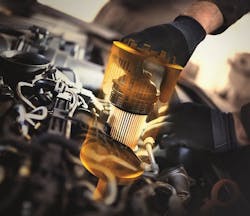Engine oil filters for gasoline-fueled engines, along with cabin air filters, will be the focus of this article. Diesel applications require a different discussion.
Typical construction of spin-on oil filters (courtesy Mahle)
Engine Oil Filter Bypass
Oil filters that feature a bypass deal with the pressure differential wherein the change in pressure from the inlet to the outlet side of the filter occurs. If the pressure differential is too high, a valve will open, allowing the oil to bypass the filter. This valve is needed so the engine does not become starved of oil if the filter clogs with debris.
Filter manufacturers commonly offer both spin-on and cartridge filters. (courtesy PGI/Continental)
Filter Media
The engine’s oil pump moves the oil directly to the filter. The oil is pushed under pressure through the filter media and back through the central hole, where it re-enters the engine.
Depending on brand and specific filter design, the filter media may consist of paper/cellulose, synthetic or microglass material.
Cellulose: This type of media can typically capture particles eight to 10 microns in size. Due to the paper construction, this type of media can become damaged by moisture/condensation.
Synthetic: Higher quality oil filters may feature synthetic or synthetic resin media (usually polypropylene), effective in removing 50% of the particles in sizes ranging from 20 to 40 microns, and 24% of particles in the eight to 10 micron range. This media is not as likely to be damaged by moisture. The compact synthetic filter media structure also helps to decrease differential pressure. Lowering pressure greatly reduces the amount of time the filter bypass valve needs to be open. During cold start conditions, the bypass valve decreases pressure to allow oil to flow freely, though unfiltered, to the engine’s oil galleries. Synthetic media better withstands the acid content of oil that results from contamination by water, ethanol, start-stop driving, etc.
Microglass: Some oil filters utilize an extremely fine metal media or microglass. This microglass mesh is made with fibers that are 10 times finer than cellulose fibers. They also present far less of a restriction to the flow of engine oil.
Spin-On vs. Cartridge
As we all know, spin-on/canister oil filters have been the norm for decades. This is a self-contained unit featuring a stamped steel housing, filter element, bypass valve, drain-back valve and rubber gasket. The filter features a female thread that engages to a male thread fitting at the engine block. Using a filter wrench, loosen and unthread the filter and dispose of it. (Some prefer to cut the used filter apart to see if any metal particles are trapped in the filter element.) Once the sump has been drained and the oil pan plug reinstalled, a bit of fresh oil is added to the new filter; the filter gasket is lightly lubed with oil and the new filter is installed. Add the necessary amount of fresh oil to the sump, start the engine and allow oil pressure to build to spec, shut off the engine and wait a minute for the oil to drain back into the sump and re-check oil level. Pretty standard and simple.
However, many OEMs have switched over to a filter approach that pre-dated spin-on filters — the cartridge style filter. This involves a “permanently” mounted canister housing into which a filter cartridge is installed, capped off with a canister lid. For those who disdain change, this move may seem an annoyance. The reason for the change is quite simple. Considering the number of oil filters that are disposed of in the course of a year is enormous, tons of steel filter bodies are wasted and sent to landfills. The use of cartridge style filters that contain no metal eliminates this waste of steel, since the metal-free filters can be fully incinerated.
Anyone who is aware of automotive history knows that early engines initially featured no oil filter, with filters in time offered as an option. Eventually, filters were added across the board, using a cartridge filter contained in a mounted housing. Over the years, spin-on filters were developed primarily to ease and simplify the task of filter service. As time progressed, and primarily driven by environmental concerns, today we see the re-introduction of cartridge filters. What goes around comes around.
Also, if the mounting design of the cartridge filter housing is mounted high and upright, the filter cartridge may be removed for inspection or replacement without the need to drain the system, minimizing the potential mess as when warm/hot oil oozes out of a spin-on filter and runs down your forearm. The downside: the sealing cap/top is often made of a plastic material that can be easily damaged if not careful, requiring a replacement lid. Also, if not installed properly, a cartridge filter can easily be damaged (twisting/crushing the element).
Since the lid requires a sealing gasket, it’s always a good idea to change this gasket with each filter change. Some cartridge filters feature a pilot tip or tube that engages the filter into the centered location. During service, use care to avoid breaking the plastic tip, as this can cause a severe blockage inside the housing if ignored. Whenever removing the old filter, always inspect the bottom of the housing for plastic debris and clean accordingly. We simply need to become accustomed to servicing these filters.
Oil Pressure
Engines that feature a cartridge style oil filter may exhibit a low oil pressure light coming on or flashing on/off at idle. This condition may be caused by oil pressure being bled off due to debris in the oil drain check valve and/or a damaged engine oil filter.
Use a manual pressure gauge to check oil pressure. If pressure is low, perform a visual check of the oil level, and the condition of the filter. If the filter’s condition is good, remove the filter and confirm proper operation of the oil filter drain check valve. If the valve does not seal or is held open, repair as necessary and re-check oil pressure.
Citing a Chevy Cruze vehicle as an example, during an engine oil change, it is possible for the plastic tabs on the filter to break off and fall into the oil filter housing. If a tab has broken off it may be lodged under the filter housing drain check valve, causing it to remain open. This will allow oil to drain back into the oil pan and reduce oil pressure. Also examine the oil filter to verify installation. If the filter pleats were damaged/smashed during installation the drain check valve may not be able to be closed.
Use the Correct Tool
Servicing spin-on oil filters typically requires the use of a compression-band filter removal tool, or a tool that engages the hex at the bottom of the filter housing (provided the filter features a multi-flat surface), or a cam-style tool that closes upon the filter housing as you rotate counterclockwise.
Obviously, all shops have one or more of these tool styles. However, when servicing a cartridge style oil filter, first and foremost, make sure that you have the correct tool for removing the filter lid on the specific vehicle at hand. These caps may be made of metal, while others are made of a plastic material which can easily be damaged if using an incorrect tool, and the cap may feature a unique tool engagement design.
On late model Toyotas, for instance, a special steel adapter tool encapsulates the lid and features grooves that engage to the male teeth on the plastic cap. If you try to use a spreader-style tool designed for spin-on filters, or a common tool such as a channel lock style wrench, you can easily deform the plastic cap as the tool squeezes it, rendering it useless and sure to leak if reinstalled. That move will require a cap replacement.
Also note that cartridge filters usually include a new sealing O-ring to allow the cap to seal at the housing. Always replace that O-ring gasket. On some Mercedes-Benz models, where the filter housing is located at the top of the engine, the cap assembly features a long plastic tube that enters the pump/sump area where the cartridge filter slides onto the tube. In addition to requiring a new O-ring where the cap seals to the housing, the extended tube will also feature several O-rings which must be replaced as well during any filter service. On other Mercedes models, while the filter housing may be up high and vertical, it may be tucked behind the intake manifold and very close to the firewall, making access a challenge. A special hex wrench adapter and long socket extension will be needed.
We point out these examples to emphasize the need for specialty tools that are required in certain applications. The point is to first understand what specific tool will be required for filter service, and to prevent an unnecessary delay if you need to obtain a tool while the customer’s vehicle is already in the shop.
Cabin Air Filters
Cabin air filters started appearing in 2000 model year passenger vehicles as a common feature. They provide the benefit of cleaner breathable cabin air.
Cabin air filters feature multiple layers of filtration. Specific design varies among brands, but in general there are layers that filter out airborne dust and pollen, activated carbon/charcoal traps mold and harmful gasses and reduces/eliminates odors. Baking soda eliminates musty odors and an antimicrobial layer suppresses the growth of mold and bacteria. Depending on brand, layers may consist of electrostatically charged micro-woven fiber for highly efficient filtration. As noted by Continental/PGI, these filters provide a high resistance to moisture. Non-woven filters offer a strong barrier against impurities and pollen, while active carbon filters provide effective protection against gas, bacteria, fungi and odors.
Cabin air filters should be changed approximately every 12,000 to 15,000 miles or once per year, depending on driving conditions. Since the environment in which the vehicle is operated (high humidity, high dust, high pollen, etc.,) plays a factor, filter changes may be recommended on a more frequent basis (perhaps twice per year).
It’s important to note that not only does a cabin air filter improve the air quality for driver and passengers, additional advantages include more efficient HVAC and defroster operation, since the filters help to prevent debris such as dirt, vegetation particles, insects, etc. from passing through the HVAC air ducts. If a cabin air filter is clogged, the A/C system must work harder to achieve air flow. Over time, a clogged filter can result in over-taxing the A/C system, leading to premature failure.
Filter replacement (for the most part) is a fairly easy task, with the filter accessed by removing the glove box. While glove box removal may have been a chore in older vehicles, today’s glove boxes are (in general) easy to remove/reinstall by simply pressing a few release tabs.
About the Author
Mike Mavrigian
Motor Age Editor
Mike Mavrigian has written thousands of automotive technical magazine articles involving a variety of specialties, from engine building to wheel alignment, and has authored more than a dozen books that crisscross the automotive spectrum. Mike operates Birchwood Automotive, an Ohio shop that builds custom engines and performs vintage vehicle restorations. The shop also features a professional photo studio to document projects and to create images for articles and books.

